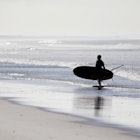
Raja Ampat: a quick guide to visiting the idyllic Papuan archipelago
May 8, 2017 • 5 min read

Picture a tropical archipelago of steep, jungle-covered islands, glittering white-sand beaches, hidden lagoons and luminous turquoise waters. Now throw in pristine coral reefs inhabited by clouds of tie-dyed fish. Place it in a remote corner of Indonesia largely unknown to foreign tourists, and you end up with the Raja Ampat islands: the ultimate tropical paradise.
- placement: fullWidth
- path: articles/in-content-top
- possible size: [970, 250], [970, 90], [728, 90], [300, 250], [320, 50], [1, 1],
- targeting:
{ "url": "raja-ampat-a-quick-guide-to-visiting-the-idyllic-papuan-archipelago" }

Why go?
It's a big call, but the collection of 1500-odd islands and islets scattered off the northwest tip of Indonesian Papua that comprise Raja Ampat is truly one of Southeast Asia's most beautiful archipelagos. If that isn't a good enough reason to put Raja Ampat on your must-visit list then consider the diving, which many authorities on the matter claim is among the world's best.
Little-known outside hardcore off-the-beaten-track travel circles until the last few years, Raja Ampat’s huge, largely pristine coral reef systems and staggering marine diversity are a diver’s dream. Described by scientists as a 'species factory', this region nestled in the heart of the Coral Triangle is home to more than 10 times the number of hard coral species found in the Caribbean.

When to go
Raja Ampat is a year-round destination, although many diving outfits cease operations between July and September, when the usually calm seas can get quite rough. For the calmest waters and best visibility for diving, aim for a visit between November and March. The Raja Ampat region receives the heaviest rain from May to October, which can also make jungle walks treacherous.

Diving and snorkelling
There are over 200 pristine diving sites in Raja Ampat where just sticking your head under the water means you'll be dazzled by a rainbow of luminous fish and corals. On a single dive you can expect to get up close with huge manta rays and giant clams, gape at schools of barracuda, fusiliers and parrotfish, peer at tiny pygmy seahorses and multicoloured nudibranchs, and, with luck, spot wobbegong and epaulette (walking) sharks, with marine topography varying from vertical walls and pinnacles to reef flats and underwater ridges. Snorkellers can observe many of these species from above, too, with many reefs easily accessible from the beach.
- placement: fullWidth
- path: articles/in-content-middle
- possible size: [970, 250], [970, 90], [728, 90], [300, 250], [320, 50], [1, 1],
- targeting:
{ "url": "raja-ampat-a-quick-guide-to-visiting-the-idyllic-papuan-archipelago" }
Raja Ampat is generally better suited to advanced divers, and is thus not exactly a learn-to-dive hot spot. There are, however, some dive spots suitable for relative novices. Most dives are drift dives, which comes with a warning: the currents that whip you along the edge of the reefs can be very strong. Proof of valid insurance and dive cards will be required at reputable dive operators. Most places provide all diving equipment.

Despite the general fishy abundance, some of Raja Ampat's reefs are more interesting than others. At Manta Sandy, between Mansuar and Arborek islands, you'll find masses of huge manta rays, some with wingspans over 5m, waiting above large coral heads to be cleaned by small wrasses. The Sardine Reef, 4km northeast of Pulau Kri, slopes down to 33m, and is home to so many fish that it can get quite dark! The fish-and-coral combination here has made it popular among underwater photographers. And despite the recent damage to coral caused by a cruise ship running aground, the waters off Pulau Kri offer some of the most celebrated dive spots. Schools of barracuda, jackfish, batfish and snapper coexist here with small reef fish, rays, sharks, turtles and groupers, and the undamaged coral is out-of-this-world beautiful.

Beyond the reef
Raja Ampat isn’t just for divers. The forested islands are home to two bird-of-paradise species (the red and the Wilson's, which can both be spotted on Waigeo and Batanta islands), along with a realm of lizards, snakes, tortoises, opossums and other birdlife. Almost every dive lodge and homestay can arrange pre-dawn tours that will take you to forest hideouts overlooking bird-of-paradise 'concert arenas'. Most homestays can also organise visits to local villages, pearl farms and cave systems, as well as arrange hiking guides.
- placement: native
- path: articles/in-content-native
- possible size: [f, l],
- targeting:
{ "url": "raja-ampat-a-quick-guide-to-visiting-the-idyllic-papuan-archipelago" }

Where to stay
Accommodation in Raja Ampat can be neatly divided into three categories. For beach bums happy to loll under the palms and engage in a bit of lazy snorkelling, the growing number of homestays are ideal – Pulau Kri and Pulau Gam have particularly rich pickings. Many homestays also offer diving, but safety standards and equipment maintenance can be questionable.
For serious divers, there are a dozen-odd quality dedicated dive resorts in the region which generally offer one- to two-week packages including transfers, meals and a couple of dives per day. Top picks include Raja Ampat Biodiversity (rajaampatbiodiversity.com) and Kri Eco Resort (papua-diving.com/kri-eco-resort). Finally, there are liveaboard dive boats, such as Grand Komodo (komodoalordive.com), which are essentially floating dive resorts which sail from one coral reef to the next. Some itineraries combine Raja Ampat with the Banda Islands off neighbouring Maluku.
How to get there
The nearest major airport to the Raja Ampat islands is in the mainland city of Sorong. There are flights here from the likes of Jakarta, Pulau Ambon (Maluku), Jayapura (Papua), Manado and Makassar (Sulawesi). From Sorong it’s a short ferry ride to Waisai, on the island of Waigeo, where homestay operators will pick you up. Most top-end dive resorts and liveaboards will pick you up from Sorong.
Getting to and from most places to stay in Raja Ampat requires using a speed boat transfer (all accommodation options offer this service), which requires a bit of planning; book accommodation and transfers in advance. Note that prices (for everything) are considerably higher than in Java, Bali, Sumatra and other more mainstream Indonesian tourism destinations.
This article was first published in February 2016 and updated in May 2017.
- placement: fullWidth
- path: articles/bottom
- possible size: [970, 250], [970, 90], [728, 90], [300, 250], [320, 50], [1, 1],
- targeting:
{ "url": "raja-ampat-a-quick-guide-to-visiting-the-idyllic-papuan-archipelago" }
Explore related stories




 Wildlife & NatureOn these remote Indonesian islands, isolation is part of everyday life
Wildlife & NatureOn these remote Indonesian islands, isolation is part of everyday lifeMay 2, 2020 • 5 min read
 Sustainable TravelTalkin’ trash: 6 beach cleans you can join in cities around the world
Sustainable TravelTalkin’ trash: 6 beach cleans you can join in cities around the worldOct 16, 2019 • 7 min read
 Wildlife & NatureChristmas Island: is this Australia’s best kept travel secret?
Wildlife & NatureChristmas Island: is this Australia’s best kept travel secret?Sep 5, 2019 • 5 min read



